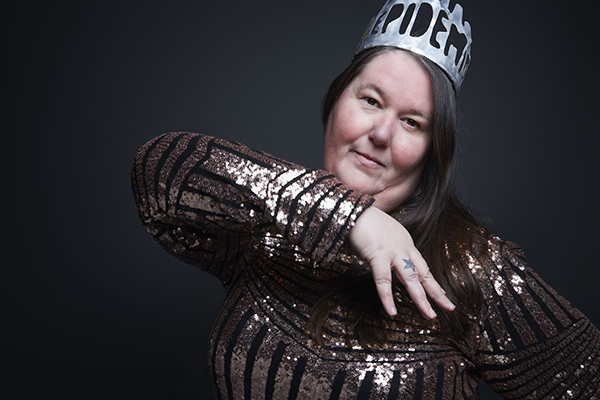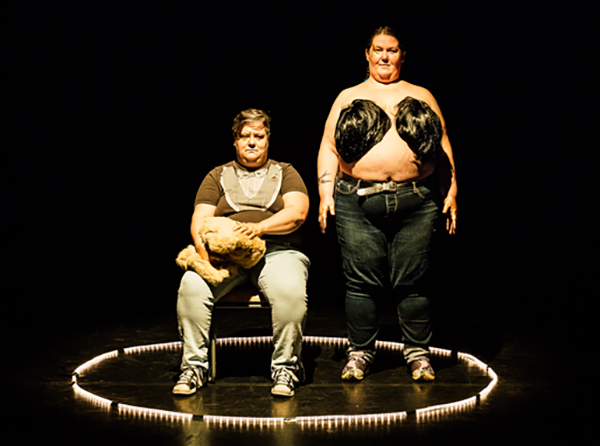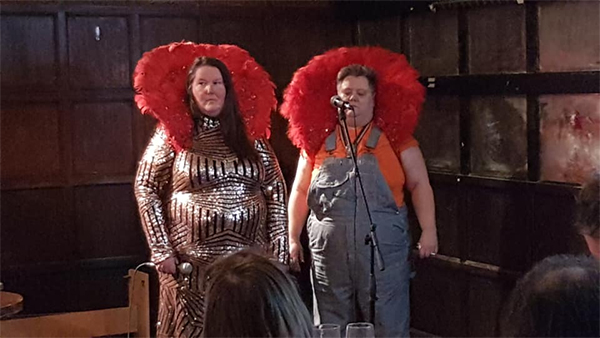An interview on the occasion of Charlotte’s ‘LADA Study Room Guide on Fat’ coinciding with the release of the government’s ‘Better Health’ campaign.
Charlotte Cooper is a writer, activist, Live Artist, psychotherapist and cultural critic – as well as a living archive of fat feminist queer activism. In August she added her invaluable contribution to the LADA Study Room Guides collection. Tantalising Glimpses: A Study Room Guide on Fat, through Charlotte’s ever-intersectional prism and exhilarating writing, gives an overview of all the things in LADA’s Study Room that relate to fat. Inevitably, it poses some critical questions – such as why fat Live Art is hard to find – and gives some hard answers – such as that this happens because of thin people feeling entitled to define the terms and the context of the conversation. Charlotte starts her Study Room Guide with a beautiful condensation one should probably learn by heart to repeat every time needed: “I love fat people and see us as part of the fabric of humanity, not a debate about health, beauty or social cost. I think fat is a political subject”.
Natalia Damigou Papoti talked with her about her Study Room Guide, her -inextricable – practice and politics, and about the Better Health campaign, recently released by the government to ‘tackle obesity’.
You wrote Tantalising Glimpses in 2020. How was the experience of working on the Study Room Guide – a guide for a Live Art library – in the midst of a pandemic when the condition of ‘live’ was unthinkable at times?
The Study Room is live in that people are there, I am there getting things off the shelves, our interactions are like funny little performances, the space is beautiful, full of energy and a bit theatrical. I missed all that when the lockdown happened. But the books, journals, pictures, moving images are no longer live, they’re a record of something, a commentary or a hint. Live Art takes place in lots of realms, not necessarily right here and now, with people in the same room breathing germs and infecting each other! The pandemic is a calamity beyond measure, but like all disasters there are important moments and turning points, perhaps even hope. I think it is revealing more ways in which we can do and think about Live Art.
There is a marvellous excerpt (among many others!) in Tantalising Glimpses where you explain why fat Live Art is hard to find. It reads:
It takes time and experience to see fat. If you don’t have the means to see and make sense of something, you’re not going to find anything. I often think of that scene in the film ‘Interview with a Vampire’ where Tom Cruise homoerotically bites Brad Pitt and Brad can see all the squirming and unsettling vampire world things that were previously hidden to him as a mortal and it blows his mind. Fat is like that – you need to be bitten by someone in the know who can accompany you to the underworld.
I think this is the best analogy I’ve come across for that very specific process of discovering and understanding the political dimensions of an issue which, thereafter, can no longer be unseen. Who was the one who bit you and accompanied you to the underworld of fat politics?
When I was young, nobody I knew was talking about fat in the ways I wanted to talk and think about it. I am working class and come from some cultural impoverishment which means I didn’t know that libraries were viable places for me until I was in my thirties. I knew about shops and I loved bookshops so I would go to bookshops week after week and stand and read the books on the shelves. I was a teenager in London in the 1980s and there was a network of feminist and radical bookshops at that time. I was interested in sex so I read everything I could find about sex. These books were often shelved next to ‘Health,’ so I started reading those and this is how I found Shadow on a Tightrope, a feminist anthology about fat oppression, published in 1983. It’s not a book about health, it’s a political book but people still can’t think of fat as anything but a health problem with political ramifications. Anyway, talk about eye-opening! I was bitten by a book. It’s still my favourite analysis of fat nearly 40 years on. A truly monumental work.

On July 27th, the same week that Tantalising Glimpses was published, the UK government released the ‘Better Health’ campaign to ‘tackle obesity’ which, on the pretext of the COVID-19 pandemic, reproduces the same old pathologising rhetoric that frames obesity as ‘a problem’ of an individual. In TG you refer to the ‘Obesity report’, published in 2000 by the World Health Organization, which accelerated fatphobia into a worldwide government policy and produced a huge backlash against movements advocating fat acceptance. Do you think that ‘Better Health’ will have an equally harmful long-term impact?
No. It is a puny little piece of crap in an ocean of fatphobic interventions that pre-exist it and will continue after it has disintegrated. It’s another turd being wielded by people and organisations that have only caca to offer. My one worry is about how the campaign was racialised, Black and Brown people’s suffering with COVID is being made into a personal moral failing apparently remedied by losing weight. But I also know that PoC’s communities are more than able to resist such stupid government posturing.
You also commented on Twitter about this war being racialised. Do you want to elaborate on this?
The campaign predominantly uses images of people of colour and I suspect this is because they want to appeal to this group as they are more heavily impacted by the virus than White people. But vulnerability to Corona isn’t about becoming thin, that’s not sustainable for most fat people who try to lose weight anyway, and I resent how living well is equated with weight loss, which is a racket. The problem of Black PoC’s vulnerability to COVID in the UK is racism, exclusion, not having access or entitlement to services, bad living conditions, not having enough money, and so on. No amount of grinning, skipping or juggling apples is going to improve that.

What came first in your life, art or activism? Do you see fat art and fat activism as distinct or you find convergences between them?
Art came first, then I got into feminism, anti-fascism/anti-racism and queer politics as I grew up. I think art and activism are the same, though I am an outlier in this respect. Most people think that activism is about changing laws, writing petitions, going on demonstrations etc. It is that but it is so much more. I elaborate on this in my book Fat Activism: A Radical Social Movement. I think activism can be anything and I suspect art can be anything too, it’s how you think about it and it’s all always political.
Your art practice combines elements of performance, dance, music, video and spoken word. When and how did you start making art?
Like many live artists I started out in school plays. I made my debut as a leaf who was nibbled by caterpillars. I played recorders and the clarinet in live performances. I was into synchronised swimming and our local group put on a ‘water pantomime’ one year. I was in the chorus, swimming around in darkness to When You Wish Upon a Star with a lightbulb strapped to my head. I studied drama and wrote plays and poems independently. I did this in secret until I was well into adulthood because I didn’t know there was a place for me in the arts and I came from a culture that ridiculed such things. I wrote a libretto (didn’t know the word back then) based on Ziggy Stardust, with me as the hero, set in my school in Wembley!
Which do you believe to be the three most significant pieces of fat art of all time?
Around 30,000 years ago, someone carved the Venus of Willendorf, a figure of a fat black woman. They knew what such a person looked like. This figure shows that fat people are part of the fabric of humanity, we have been here for as long as people have been here.
Steve Post’s Fat-In from 1967. A prank in New York riffing on hippie performance tactics and happenings. Only some people took it seriously, including Llewellyn Louderback, who went on to write Fat Power in 1970, which then influenced a whole load of fat activism.
I know it’s unseemly to boast about your own collaborations but SWAGGA, with Project O from a few years ago, presented fat people as complex, intersectional, expressive, embodied and fully worthy of taking up artistic and poetic space in the avant-garde on our own terms. This should be the norm but it isn’t.

Recently you wrote on Twitter that the “generations who were subjected to stigmatising and egregious school anti-obesity campaigns are now coming of age and making art about it”. What do you think of this new generation(s) of artists? Which artists would you recommend to someone interested in fat art?
I’m deep in middle age so not the best person to opine about young people, you’re better off asking them. But I really like Chubb Rubb’s aesthetic. His look is so original and queer, art is supposed to help you see things differently and that is what he does. He’s very messy and emotional, intense, funny and weird. He’s got a handle on lots of different forms and makes things in a DIY way, which I love. I hope I get to see his practice develop over time.
‘Punk’ was one of the first words that came to my mind when thinking about you and all the dimensions of your practice – with its initial connotations of opposition, criticality and rejection. Later on, I discovered that it’s one of the words you’ve been using to describe it as well. What does it mean to you to be punk, nowadays?
My friend Linda McKay died this year. I met her when I was 15, she was 20 years older. In the drag world you have house mothers, Linda was that equivalent for me in punk, I can never repay her for the gifts she gave me. From her and her husband John I understood punk to be about making your own world, rejecting bullshittery, valuing things that are non-normative. It’s an assertive femme sensibility, it’s ragged and there’s a lot of subversive humour in it. Some types of punk have been commodified, perhaps I am doing that now by trying to describe it, but it remains an approach that is dear to me, even spiritual.
Your practice and overall stance are essentially and deeply political, in the sense that one bears witness to what it means for ‘intersectionality’ to be translated into art, thinking, words, as well as a general attitude to life and creativity. How do you feel with the often vacuous use of words such as ‘queer’, ‘feminist’ and even ‘radical’ -mainly in the arts and the academy- by individuals embedded in, as well as willing to happily reproduce, mechanisms and structures that these theories have been heavily criticising and aim to dismantle?
It’s annoying but it’s also symptomatic of the times we are in. Words take the place of meaning. There’s a simple way around it, which is to take a look at what people actually do rather than what they say they are doing or being. It’s easier to make my mind up about whether or not I think something is queer, feminist or radical when I’ve given myself a chance to look beyond the rhetoric or sales pitch.

You wrote a brilliant text entitled “Some suggestions for people who are rich and privileged and who may need help in managing it”, which tackles a huge art world taboo: that some people in the arts have safety nets, inheritances and social capital they never talk about (sometimes while they simultaneously and shamelessly talk about class and precarity). What do you think of it now?
That piece was on a blog that I ended when I got freaked out about privacy and surveillance capitalism and recognised how important it is that I own my work and not provide corporations with content for free. I needed to vent at the time because I was going through painful break-ups around class and privilege. The piece was a bridge going up in flames. What I think about it now is that I have an ambivalent relationship to the voice that that piece is written in, it’s certainly punk, a performance voice, one that easily gets attention and is full of righteous energy. I love the part of me that can access this voice but it’s not all of who I am. I might publish it again in a different form and, if I do, I will try and include more of that ambivalence, vulnerability, the grey areas between the compelling black and white certainty of the piece. You can tell I’m menopausal! I’m busy shifting into a new life stage and looking at things differently now.
The video Dead you’ve made with Kay Isgay as Homosexual Death Drive is an utterly striking piece of work – dreamy yet deeply existential in a way that only the implication of death can evoke. You managed to capture the fleeting sensation of being surrounded by the vastness of the sea and juxtaposed it with a song that is a glorious and powerfully tender feminist anthem; “Don’t wait for permission”, you sing as two bodies are swirling underwater. How did this work occur and what does it mean to you?
I was in Australia in 2010 and feeling suicidal. I took walks in the bush without telling anyone and was flirting with disappearing. I was heavily in grief and thinking about my beloved brother Paul, who died when he was 24. The song came to me as I was walking. I came out of the bush again. Later that year Kay and I had the opportunity to perform, our first outing as Homosexual Death Drive, and we sang it there. People are very moved by the song and sometimes it is hard to sing it without crying. For me it’s a song about staying alive and really living because after death there is nothing. Later I was on holiday in Gozo in a place with a pool where I could swim naked. I love being in water and had an old phone, which I wrapped in sanitary towels to keep dry and put in an airtight plastic box, that’s why the picture is grainy and strange. I used this to film Kay and me in the pool at different times of the day. I don’t know if I thought “this is the video for Dead” but the song and the images came together on my computer. I love your interpretation of the piece, thanks for giving me the opportunity to tell this story. I think of us as queer angels of death.
Are you working on something right now you’d like to talk about?
Yes, quite a few things. I’ve been returning to writing, which is my root, and creating texts which can be developed for performance in time, when I am ready. Right now this is a memoir. I’m looking for a publisher.
I am also a psychotherapist and am developing creative work around that, mostly drawings of what therapy looks like, a big essay about therapy and performance and a book about my fat somatic practice, using movement to heal from fatphobia.
I’m getting ready for a new edition of Fat Activism to hit the shelves next year. I’ve written a fab new preface for it which takes in COVID, Black Lives Matter and more.
I’m producing electronic versions of all my Story zines, and my novel Cherry, and cataloguing my archive.
I’m not waiting for permission.
You can download Charlotte Cooper’s LADA Study Room Guide Tantalising Glimpses here.
Charlotte Cooper’s e-Book Fat Activism Vernacular can be purchased here, and her book Fat Activism: A Radical Social Movement here.
More info on Charlotte’s work and writing, on her website here.
Natalia Damigou-Papoti is a writer, mainly interested in sexuality, desire, feminism, and gender in the realm of pop culture. Since 2017 she has been working in Live Art festivals and events and since 2019 at the Live Art Development Agency. She was one of the co-founders of UNCENSORED Festival exploring the intersections of pornography, art and activism.
